Deprecated: Automatic conversion of false to array is deprecated in /home1/cramfarm/public_html/wp-content/plugins/zilla-likes/zilla-likes.php on line 320
0
Swarm Traps
Deprecated: Automatic conversion of false to array is deprecated in /home1/cramfarm/public_html/wp-content/plugins/zilla-likes/zilla-likes.php on line 220
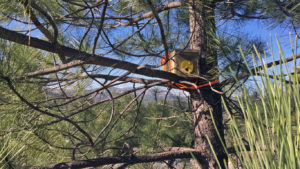
Swarm Trap placed in a pine tree, I try and look for a high spot in the landscape to place the trap.
When I began to pursue beekeeping I always wondered where the bees would come from. I couldn’t just go down to Wal-Mart or Target and pick up a colony of bees. Upon more research I listened to a podcast about a beekeeper who set swarm traps and that is how he got his bees. Eureka! What a great way for nature to provide a solution that is local and accustomed to the area.
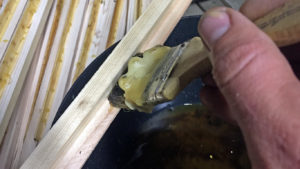
Brushing melted wax onto a starter strip inserted into the frame, this gives the bees a path to build comb. The wax also provides a scent the bees know and like within the trap.

The boxes I use have 6 frames inside with a starter strip on each frame.
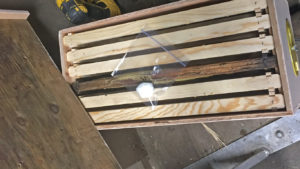
To provide an additional scent along with the wax on the frames is a cotton ball with 5-6 drops of lemongrass oil placed into a small bag.
I look forward to spring every year because it is time to set out swarm traps, wait to see if any bees will find the boxes, and they will settle into a new home. I remember reading that some historians feel this could have been the beginning of early beekeeping when a swarm would settle into an empty clay vessel thus enabling a moveable colony of bees. Instead of using a clay vessel I build a box to hold six frames and that has a rotational doorway to close off or narrow down the entrance if needed. Over the years I have modified the boxes by drilling holes for ventilation (if it is too much the bees just fill them in with propolis) and an insulated lid for to help with temperature changes in the mountains. I also build some top bar hive swarm traps that have worked well for populating top bar hives. I usually crumble up some old comb, add frames or top bars with a starter strip coated in beeswax, and a cotton ball with some lemongrass oil drops on it placed in a bag to increase the life of the odor.
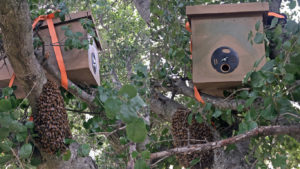
This was a unique find and my only thought is 2 swarms found this box and one settled in first. For the bees on the tree I brought out another box and scooped them into the box.
The swarm trap has also been a good indicator of feral bee health in the area where the trap is placed. I am finding that once I catch a swarm in a given area, I can set a trap there the following year and have high rate of success. This past year the nectar flow was so good there were multiple swarms in areas where I would put traps.
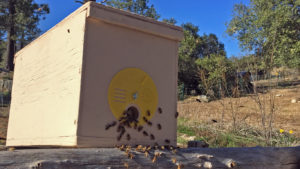
A group of bees gathered on our garden archway so I placed a box next to them and they soon began marching into the box once they caught the scent.
Another use is when I do a removal and I feel there is a high probability of another swarm occupying that space is to place a swarm trap nearby. Most homeowners like the idea of them settling into a box that they call me to retrieve as opposed to having to do a full-scale removal again and again. This is a wonderful opportunity to be an advocate for bees and keeping a positive outlook for local people in the communities I keep bees.

Swarm trap baited and ready.




